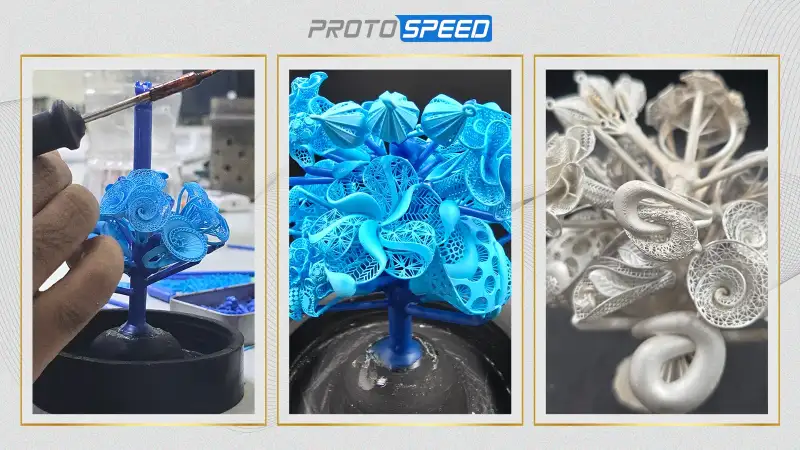Role of Invisible Oxidation in Setting the Melting Point on Casting Machines
In the world of jewelry casting, precision is everything. Melting precious metals like gold and silver requires strict temperature control to ensure clean flow, complete mold filling, and defect-free castings. However, a hidden factor often affects this process—invisible oxidation.
In this article, we explore how invisible oxidation influences melting behavior, how it can mislead machine settings, and how the use of borax as a flux helps control oxidation during melting.
What is Invisible Oxidation?
Invisible oxidation refers to the formation of microscopic oxide layers on the surface of metal. These oxides develop when metal is exposed to air, moisture, or repeated heating cycles, even if no visible discoloration is seen.
This is especially common in:
• Scrap gold and silver
• Metal stored for long periods
• Metal repeatedly heated in open environments
Though these oxides are often undetectable to the eye, they significantly affect how metal melts and behaves during casting.
How Invisible Oxidation Affects Melting Point
Apparent Increase in Melting Temperature
Oxide layers act as insulators on the metal surface, which slows heat absorption. As a result, the metal may appear to require a higher temperature to begin melting, even though its actual melting point has not changed.
Delayed or Incomplete Melting
Metals with surface oxidation melt unevenly. In some cases, the interior may remain solid while the surface begins to flow, leading to poor fluidity and incomplete casting.
Misleading Casting Machine Calibration
When operators rely on visual cues or performance of oxidized scrap to set melting temperatures, they may unintentionally overheat the metal. This can lead to:
• Grain coarsening
• Increased porosity
• Loss of trace elements like zinc or silicon
Alloy Composition Shifts
Oxidation can cause selective loss of reactive alloying elements, particularly in gold and silver alloys. This changes the behavior and melting point of the alloy over time.
Role of Borax in Controlling Oxidation
One of the most effective ways to manage invisible oxidation during melting is by using borax as a flux.
What is Borax?
Borax (sodium borate) is a naturally occurring mineral commonly used in metal refining and casting. It melts at a lower temperature than most metals and flows over the surface of molten metal, creating a protective barrier.
How Borax Helps During Melting
Dissolves Surface Oxides
Borax chemically interacts with oxides on the metal surface, helping to break them down and float them away as slag. This promotes cleaner melting and improved flow.
Prevents Further Oxidation
Once molten, borax forms a glassy layer on the surface of the metal. This seals it from air exposure and reduces further oxidation during the heating process.
Preserves Alloy Integrity
By limiting the oxidation of reactive elements like zinc and silicon, borax helps maintain consistent alloy composition. This is especially important when melting scrap or reused metal.
Improves Casting Results
The use of borax leads to smoother melting, better mold filling, and fewer defects—resulting in higher casting quality with fewer issues like porosity or surface roughness.
Limitations of Borax
While borax is highly effective on the molten surface, it has limitations:
• It cannot remove deep internal oxidation
• It does not clean contaminated scrap (e.g., solder or polishing residues)
• Excessive use can create slag that interferes with pouring
Therefore, borax should be used as part of a comprehensive melting protocol rather than a complete solution.
Best Practices for Managing Oxidation in Jewelry Casting
To reduce the impact of invisible oxidation and improve melting performance:
1. Always clean scrap metal before melting
2. Use borax during melting to dissolve oxides and protect the molten surface
3. Mix scrap with fresh grain to balance melting behavior
4. Melt under inert gas or vacuum when possible to reduce oxidation
5. Avoid overcompensating by increasing temperatures based on oxidized scrap
6. Calibrate your casting machine using clean, freshly refined metal
________________________________________
Conclusion
Invisible oxidation is a subtle yet critical factor that affects melting behavior in jewelry casting. Left unchecked, it can lead to incorrect melting point assumptions, alloy inconsistencies, and casting defects. The strategic use of borax as a flux offers an effective way to manage surface oxidation, protect alloy integrity, and support consistent melting results.
By combining borax with proper scrap management, clean melting environments, and accurate temperature calibration, manufacturers can maintain high-quality castings and prolong the life of their metal.

